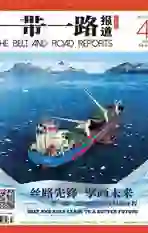防灾减灾是国际合作的“最大‘公约数’”
2019-09-10雷露彭纳
雷露 彭纳

2015年4月25日14时11分,尼泊尔首都加德满都在一阵地动山摇之后,随即被笼罩在了尘埃之中。4年过去,如今的尼泊尔已经从那场8.1级的地震中恢复了平静,只有杜巴广场上那些还在修复重建的寺庙、楼宇,提醒着人们,这里曾经发生的灾难。
人类扩张活动版图的历程,也是人类与自然相融相争的一部史诗。从近两千年前,被火山付之一炬的庞贝古城;到2004年,印尼北部苏门答腊岛亚齐省海域发生里氏8.7级地震,引发强烈海啸;到2008年5月12日,汶川特大地震留下的伤痛;再到2010年1月,巴基斯坦北部罕萨谷Atabad山体滑坡形成堰塞湖,淹没数个村庄和部分喀喇昆仑公路……而这其中,汶川特大地震影响尤为严重,是中华人民共和国成立以来破坏力最大的地震,为此国务院特批,自2009年起,每年5月12日为全国“防灾减灾日”。
从地质构造及板块活跃度来看,“一带一路”沿线国家与地区地质构造复杂、地震活动频繁,加之受季风气候影响,降水集中且强度高,地震、地质、气象、海洋等自然灾害极为发育。据联合国灾害数据库数据显示,“一带一路”沿线国家相对灾害损失是全球平均值的2倍以上,灾害死亡率远远大于全球平均水平,其中南亚和东亚地区高出全球平均数的10倍。
“一带一路”沿线国家大多是发展中国家,这些国家应该如何提高防灾减灾能力,满足当地经济社会发展安全需求?各国应该如何联合行动,开展更加有效的防灾减灾行动?
5月11日-12日,“一带一路”防灾减灾与可持续发展国际学术大会上,来自全球40余个国家和地区的780余名专家学者齐聚北京,为科学应对“一带一路”沿线国家共同面对的减灾需求,推动落实联合国《2015-2030年仙台减少灾害风险框架》《巴黎气候变化协议》和《2030年可持续发展议程》,携手国际伙伴共建科技协同减灾机制建言献策。
The history of human’s expansion activities is also a process of integration and struggle between human and nature. About 2,000 years ago, Pompeii was ruined by volcanic eruption; in 2004, a major earthquake of 8.7 magnitude happened in sea area of Aceh, Sumatra in north of Indonesia, triggering strong tsunami; on May 12, 2008, the 2008 Wenchuan earthquake jolted China; in January 2010, a landslide happened in Attabad Lake, Gojal Valley in north of Pakistan, submerging several villages and part of China-Pakistan highway. Among those disasters, 2008 Wenchuan earthquake was the most devastating. In this connection, the State Council approved May 12 as “Disaster Prevention and Mitigation Day” since 2009.
Judging from the geological structure and plate activity, countries and regions along the Belt and Road (the route) have complex geological structure and frequent seismic activity. These, plus impacts of monsoon climate and intensive and strong precipitation, make those countries and regions vulnerable to earthquake and other natural disasters of geology, meteorology, and marine. According to disaster database of the UN, the relative disaster loss of countries and regions along the route is more than two times of global average, and the disaster mortality is far higher than global average. Moreover, those of South Asia and East Asia are 10 times above global average.
Most of these countries are developing ones. So, what should they do to enhance the capacity of disaster prevention and mitigation and meet local demands for security of economic and social development? What measures should they take to act together and launch more effective disaster prevention and mitigation activities?
On May 11-12, at International Conference on Silk Road Disaster Risk Reduction and Sustainable Development, some 780-plus experts and scholars from 40-plus countries and regions gathered in Beijing International Convention Center. They offered suggestions and insights on how to tackle with the common disaster mitigation demands of countries and regions along the route, implement the UN’s Sendai Framework for Disaster Risk Reduction 2015-2030, Paris Agreement, and 2030 Agenda for Sustainable Development, and how to co-build a coordinated technological disaster mitigation mechanism together with global partners.
2018年8月12日凌晨,四川茂县南新镇牟托村水磨沟组受短时降雨影响,突发泥石流灾害,因在灾害发生前,监测预警工作及时到位,为紧急避险转移赢得了宝贵时间,共转移240余人,未造成人员伤亡。这次成功的转移是科学防灾减灾的一次有效实践。
如何利用科学手段,在防灾减灾上提高效率,成为本次大会的一个重要议题。
会上,专家学者们围绕灾害数据调查与共享、形成机理与物理过程、风险分析与管理、监测及早期预警、防灾减灾与应急管理、灾后恢复重建、跨境灾害风险防范、可持续发展等议题作了探讨,提出要在“一带一路”框架下,聚焦减灾与可持续发展,充分凝聚国际共识,谋划减灾科技合作新路径,搭建国际协同减灾新平台,致力于促进各国更加科学、更加有效地应对重大自然灾害风险,为推动沿线国家可持续发展、增进各国民生福祉给出科技方案,为共建“一带一路”和促进各国共同繁荣提供有力的科技支撑。
在“一带一路”防灾减灾与可持续发展国际学术大会铁道工程分论坛上,中国中铁二院工程集团有限责任公司总经理朱颖分享了成兰铁路减灾选线的“中铁智慧”。
建设中的成兰铁路,位于成都平原向青藏高原边缘过渡区——川西北三角形断块区,主要构造由龙门山褶皱断裂带、西秦岭褶皱断裂带和次级岷江断裂带组合而成。该区域位于著名的“南北向地震构造带”的中段,是我国活动断裂和地震强烈的集中地带之一。
朱颖介绍说,“山区铁路选线,要以规避、防范铁路全寿命周期(建设及运营期间)可能发生的地质灾害为根本出发点,降低、减小铁路工程建设及营运期间的地质灾害风险损失。”
因此,在成兰铁路施工的过程中,在满足线路宏观走向的情况下,为最大限度降低龙门山断裂带(束)对线路及工程的影响,规避沿线不良地质,避免地震引起的山体失稳、泥石流、危岩落石等次生灾害,线路东移,经龙门山前山断裂破裂的末端、地震次生灾害相对明显较轻的间隔性廊道,采取隧道形式大角度穿越龙门山活动断裂带,避开岷江河谷下游严重的岸坡稳定问题。
在经济全球化趋势下,科技创新是应对气候变化、自然灾害等全球性问题的重要出路。而成果的共享,则是提升风险防控最行之有效的路径。
当中国科学院院士崔鹏在谈起成果共享的话题时,提起了他曾经征战的喀喇昆仑公路。
喀喇昆仑公路是一条连接中国西部与巴基斯坦的交通大动脉,也是世界上平均海拔最高的跨境国际公路之一,地质情况极为复杂,区域内雪崩、泥石流、山体滑坡、塌方等地质灾害频发。
复杂的地质条件,意味着无数的未知风险。在公路修建的10余年里,多名中巴建设者献出了宝贵的生命。进入新世纪后,巴基斯坦对这条公路提出了扩建升级需求,提高道路的防灾标准和通行能力是当务之急。
2008年,扩建升级项目正式启动。与建设之初相比,40年后的施工条件发生了翻天覆地的变化,但巴基斯坦北部的地质条件依然给工程带来巨大挑战。2010年,项目中段发生严重山体滑坡,垮塌的半座山截断了山下的河流,形成20多公里长的堰塞湖。

面对这样一个堰塞湖,中方团队专门请来了从事泥石流等山地灾害研究20多年的崔鹏院士,经过综合考察、科学评估,崔鹏团队提出了堰塞湖改线的应对措施,即通过新建5条总长7公里的隧道,同时架设4座桥梁并铺设14公里路面,来解决堰塞湖难题。
2013年11月,除改线段外,喀喇昆仑公路改扩建工程一期全部完工。2015年9月,堰塞湖改线工程通过验收。
气候变化和灾害影响是当前全球共同关注的问题,特别是基础设施建设可能带来的灾害加剧、生态退化、环境破坏等影响,除了运用科学技术积极应对外,也需要国际社会通力合作。
为此,在此次学术大会上,由中国科学院水利部成都山地灾害与环境研究所、四川大学灾后重建与管理学院、中国科学院地理科学与资源研究所共同发起的国际减灾科学联盟正式成立。同时,参会的中外科学家还共同发表了《“一带一路”防灾减灾与可持续发展北京宣言》,提出将共同致力于加强科技及政策交流,推进构建“一带一路”自然灾害风险防范协同机制。
早在2013年,中国科学院成都山地灾害与环境研究所就与意大利国家研究委员会水文地质灾害防治研究所达成共识,建立中意山地灾害联合实验室。实验室建成后,先后开展了“滑坡、泥石流监测与风险管理”等项目研究,为双边紧密合作与交流,加强泥石流、滑坡等山地灾害防治的研究工作打下了坚实基础。
中科院院士崔鹏在接受记者采访时表示:“建立联合实验室对提升中意两国防灾减灾的科研水平,促进两国减灾事业的发展和实现科技惠民目标均具有重要意义,能有效促进两国互惠共赢!”他认为,科学的防灾减灾是沿线国家共同面临的重大现实问题,也是各国间合作的“最大公约数”。
中国科学院院长、“一带一路”国际科学组织联盟主席白春礼:
科技创新与国际合作对于“一带一路”沿线国家和地区携手应对重大自然灾害风险、保护生态环境安全和实现国际社会经济繁荣与可持续发展具有重要意义。作为中国的科技国家队,中国科学院有责任和义务为建设安全、绿色、可持续发展的“一带一路”贡献科技智慧和力量。
Bai Chunli, President of Chinese Academy of Sciences (CAS) and Chairman of Alliance of International Science Organizations in the Belt and Road Region:
Scientific and technological innovations are of great significance to countries and regions along the route as they seek to tackle with major natural disasters and risks, protect ecological environment and security, and realize economic prosperity and sustainable development of the international community. As a national technological player in China, CAS is duty-bound to offer intelligence and power for the efforts of building a secure, green, sustainable Belt and Road.
中国科学院院士崔鹏:
丝绸之路是中方和西方文化交融的一个途径,但是这个地区自然灾害类型多样、频繁成灾,对人身安全和社会经济发展造成了危害,防灾减灾是该地区最基本的需求。我们举办防灾减灾大会,希望通过国际合作来提升应对灾害的能力。
Cui Peng, Academician of CAS:
Silk Road is a route for cultural fusion between China and the West. Yet this region is vulnerable to varied and frequent natural disasters, which means risks to human safety and social, economic development. Therefore, disaster prevention and mitigation is the basic demand of the region. By hosting the conference, we hope to enhance our capacity in coping with disasters through international cooperation.
生态环境部副部长黄润秋:
由于强烈的构造运动、脆弱的生态环境,加上频繁的极端气候,“一带一路”沿线许多地区,都受到各种地质灾害的严重威胁,我们需要携手并进,加强科技合作,分享不同国家的科技创新成果,构建更有效的减灾平台。
Huang Runqiu, Vice Minister of Ecology and Environment of the People’s Republic of China (MEE):
Because of the intense tectonic movement, fragile ecological environment, and frequent extreme climate events, many regions along the route suffer from severe threats of various geological disasters. Therefore, we should join hands to intensify scientific and technological cooperation, and share our scientific and technological results, in a way to build a more effective disaster mitigation platform.
國际地理联合会副主席傅伯杰:
从可持续发展的角度出发,希望加强与“一带一路”沿线国家在防灾减灾、灾害风险管理等方面的科技交流,深化合作研究,进一步发挥地理科学及学术组织的作用,帮助人们了解和应对灾害及灾害风险。
Fu Bojie, Vice President of International Geographical Union:
From the perspective of sustainable development, we hope to intensify technological exchanges with countries and regions along the route on disaster prevention and mitigation and disaster and risk management. We should deepen research cooperation, give further play to the role of geographical science and academic organizations, and make people learn more about and cope with disasters and risks.
中国中铁二院工程集团有限责任公司总经理朱颖:
以防灾减灾为切入点推进“一带一路”倡议,不仅有助于防范和减少自然灾害造成的冲击,维护国际经贸合作的有序开展,推动“一带一路”倡议的纵深发展,也有利于促进沿线国家人民的民心相通,加深各国人民间的互信和友谊。
Zhu Ying, General Manager of China Railway Eryuan Engineering Group Co., Ltd.:
With disaster prevention and mitigation as a starting point, the efforts of pushing for the Initiative can help prevent and reduce the impacts of natural disasters, safeguard orderly international trade and economic cooperation, motivate the further development of the Initiative, and contribute to closer people-to-people bond among countries along the route and deepen their mutual trust and friendship.
中国中铁股份有限公司科技与信息化部副部长刘涵宁:
开展“一带一路”沿线国家防灾减灾研究与国际合作,树立灾害风险意识和综合防灾减灾理念,加强沿线各国在防灾减灾领域的沟通交流与合作,建立自然灾害的监测及联防机制,提高沿线国家抵御自然灾害风险的能力,对“一带一路”倡议具有十分重要的意义。
Liu Hanning, Deputy Head of Technology and Informatization Department of China Railway Group Limited:
It is of great significance for us to launch disaster prevention and mitigation research and international cooperation in countries and regions along the route, establish disaster risk awareness and comprehensive concept of disaster prevention and mitigation, intensify communication, exchange and cooperation among these countries on disaster prevention and mitigation, set up monitoring and joint prevention mechanism of natural disasters, and enhance the capacity of these countries in tackling with natural disasters and risks.
联合国环境署政策司灾害管理处处长亨里克·斯洛特:
气候变化和灾害影响是当前全球共同关注的问题,希望国际科学界携手合作,共同应对灾害和气候变化的影响,共享科技创新成果,切实减少各类灾害风险,为实现全球经济社会可持续发展和人类生产生活安全贡献智慧和力量。
Henrik Slotte, Chief of the Crisis Management Branch of the United Nations Environment Programme (UNEP):
Climate change and disasters are common concerns for global community. We hope international scientific community work together to cope with the impacts of disasters and climate change, share results of scientific and technological innovations, and reduce the risks of various disasters and risks, so as to contribute intelligence and power for sustainable economic and social development worldwide and for the safety of mankind’s production and life.
聯合国减灾署亚太区项目官员蒂莫西·威尔考克斯:
通过本次大会,希望加强自然灾害及风险管理中的多学科综合性研究,为各国有效应对灾害风险不断创造新的解决方案,促进2030年全球减灾目标的逐步实现。
Timothy Wilcox, Head of UNISDR’s Sub-Regional Office in the Pacific:
Via this Conference, we expect multi-disciplinary research in natural disaster and risk management. We should provide new solutions for countries to tackle with disasters and risks, so as to gradually realize global disaster mitigation goals of 2030.
